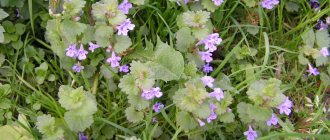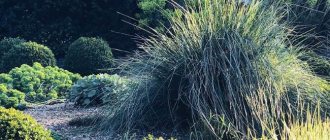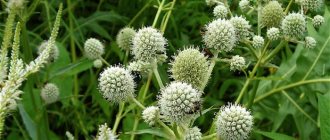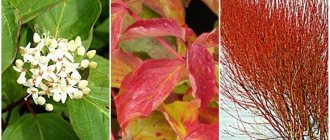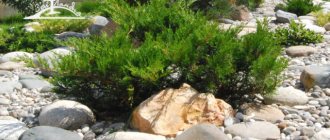Description of the crown
A herbaceous plant with delicate green leaves and stem. The leaves are attached to the stem from below and grow large, spreading along the ground. Small white flowers, vaguely reminiscent of a lily, with six petals collected in clusters of inflorescences on a thin long peduncle. Small yellow stamens look contrasting against the white background of the petal. Flower diameter 4 cm, minimum 1 -1.5 cm. A total of 70 species of broom are cultivated.
The following types are most popular in Russia:
- Anthericum ramosum – branched corolla;
- Anthericum liliago - corolla liliago or simple, lily
Branched corolla
Branched corolla flower Anthericum ramosum photo flower beds
The branched corolla is common in the wild in the southern lands of Europe and Russia. It grows on rocky slopes and in mountain gorges, sometimes it can be found in meadows and very rarely in the forest zone. The stem reaches a height of up to half a meter. Leaves protruding in different directions spread along the ground, reaching a length of 70 cm.
Individual flowers are collected in racemes, one with a diameter of 1 cm to 2 cm. Active development begins in the spring, when the sun begins to warm up, and until mid-September - until the first frost. The inflorescences begin in July, pleasing the eye with delicate flowers for 1-1.5 months.
Corolla liliago, simple, lily
Corolla simple lily herbaceous plants for open ground
It grows naturally in the Mediterranean lands, Asia, and western Europe. Loves sunny meadows, light undergrowth, small hills and hills. This flower is slightly larger than the one described above, the stem stretches up to 60 -70 cm. The size of a single flower is from 3 to 4 cm. The brush consisting of these flowers can contain up to 20 flowers, which are supported on short, thin pedicels.
The inflorescence has a pleasant aroma, attracting insects for pollination. Long spreading leaves, have a densely rich green color, grow up to 45 - 50 cm. 5 - 6 cm wide.
Growing and caring for corolla
The plants reproduce well both by seeds and by vegetative means, i.e. the usual division of the bush.
How to plant corolla seeds in open ground
How to sow broom seeds photo
- Seeds are sown in early autumn so that the plants germinate and become established in the ground before wintering.
- At the end of October - beginning of November, when the first frosts occur, it is necessary to cover the plants for the winter with leaves or covering material.
- In the spring, at the end of March - beginning of April, when warm weather sets in, the protective cover is removed to free the seedlings for further growth.
- After sowing, you can expect the first flowers in the second or third year.
Main advantages and possible difficulties
Among the main advantages of the broom are:
- They grow well on calcareous soils;
- Unpretentious in choosing a place - sun or slight shade;
- Divided bushes take root with almost 100% probability and grow quickly;
- It is not afraid of pests and copes with diseases with a bang.
One of the advantages of this plant: you most likely will not have to deal with pests.
Among the difficulties that you may encounter while growing broom, the following can be highlighted:
- You cannot replant a corolla that has already been planted in open ground;
- It may happen that due to excessive soil moisture or the lack of a drainage system in the soil, the roots of the corolla will begin to rot, and mold will appear on the surface of the soil;
- Due to poor light, poor soil and lack of fertilizing, the plant will bloom poorly with small, rare flowers;
- Being in direct sunlight most of the day and not receiving proper watering will cause the leaves and stems of the plant to become limp and dull;
- Although the corolla has good immunity, it is still better for you to familiarize yourself in advance with ways to combat spider mites, aphids and mealybugs, which rarely attack the corolla.
Description of the broom plant
Corolla or antericum is a herbaceous perennial. Stems and leaves are bright green. Creeping large leaves are attached to the stem from below. Small flowers with snow-white petals with bright yellow stamens in the middle. The flowers of the corolla are somewhat similar to a miniature copy of lily flowers. They can grow from 1.5 to 4 centimeters in size. There are approximately seventy different species of this herbaceous perennial. The most popular of them are: lily corolla, simple corolla, lilyago and branched corolla.
Planting and caring for corolla in open ground
The best time to plant broom seeds in open ground is considered to be early autumn. Planting this early will allow the seeds to germinate a bit and get stronger for the coming winter. You need to deepen the seeds by about a couple of centimeters so that they do not freeze. The distance between seeds should be at least 15 cm.
Before the onset of the first cold weather, it is necessary to carefully insulate the young shoots of the broom. To do this, cover them with a thick layer of dry foliage and cover them with any covering material on top. With the onset of spring, when the soil has warmed up well and frosts will definitely not return, the winter insulating layer of leaves and covering material must be removed in order for the plant to begin to actively grow.
Only plants that are more than two or three years old bloom. Therefore, you should not wait for flowering in the first year; during this time the corolla will gain more strength and in the future will delight you with its abundant flowering.
If several seeds sprouted too closely at the same time, the weaker one must be carefully removed.
First steps after purchase
When buying Broom in a store, you need to pay attention to the condition of the stems and leaves. Purchasing a healthy plant is the key to avoiding problems in the future.
It is recommended to carefully inspect the root rosette; this is where small insects like to hide, which are not so easy to remove. Yellowing leaves, dry ends, brown spots, suspicious spots, mold on the surface of the soil are a sign that the plant is sick or damaged by pests.
If the choice of plant occurs during the budding period, it is worth looking for a specimen with a large number of unopened flowers. A mature plant can be quite tall (about 0.5 m), so it would be a good idea to think about transportation so as not to damage the stems and inflorescences along the way.
At home, the newcomer must be given time to get used to it. There is no need to rush to “introduce” it to the rest of the flower collection. The path will remain in quarantine for a while, before which it is necessary to treat the Broom with an anti-pest solution. After 7–10 days, you can safely place it in a permanent place.
When choosing seeds, be sure to look at the expiration date and their appearance. They should not be stuck together or show signs of mold.
Reproduction of the crown
The broom can be propagated by dividing the bush. With this method of propagation, the plant can please you with its flowering already in the first year.
In order to divide the roots, you need to carefully dig up the root system of the plant and divide it so that at least three living buds remain on each part. Before planting, you should dig holes in advance and water them generously. You shouldn’t deepen the plant too much; just sprinkle a little soil and press it down with your hands. After planting, it is necessary to water abundantly and mulch the soil around the plant with sawdust, hay, forest needles or dry leaves.
The plant should be planted in a well-lit place. As for the soil, it is better to give preference to calcareous or clay soil with pre-applied fertilizer from rotted leaves.
The depth of the holes for planting the broom should be approximately 10 cm, and the distance between the bushes should be at least 30 cm. Dividing the bushes should be done every four years; this will help not only to propagate the broom, but also to rejuvenate it, thereby improving its condition. The best time for spring planting is considered to be mid-April to mid-May, and for autumn planting - September.
Secrets of success
The plant needs moderate watering. It is recommended to moisten the soil with water at room temperature, which has previously settled, preferably for at least a day. During the flowering and active growing season, the bush drinks more than usual, so you need to make sure that the earthen lump is not too dry. At this time, the Broom needs to be fed. To do this, you need to apply a diluted complex mineral fertilizer. In winter, water the bush less often than in summer and spring.
The plant can be propagated by seeds, which are planted in the fall. Young shoots will appear in the spring. Such seedlings will delight you with delicate flowers only in the 2nd or even 3rd year of life. A faster way to get an adult plant is to divide the overgrown bush into 2 independent parts. Each half should have a sufficiently developed root system and ground part. Propagation is carried out immediately after flowering (in autumn) or early spring. The delenka must be deepened into the soil, which is prepared in advance. This must be a substrate of neutral acidity.
The undeniable advantage of the Broom is its resistance to diseases and pests. Caring for the plant is not at all difficult, despite the fact that it retains its decorative effect all year round.
Types of corolla
Branched corolla - in the wild, branched corolla grows on mountain slopes, in gorges and less often in meadows. The plant can reach a height of up to one and a half meters, and its creeping leaves are up to 70 cm in length. The flowers are not large, their diameter is no more than 2 cm. Flowering begins in July and ends at the end of August, less often at the beginning of September.
Lily corolla, simple, lilyago - this corolla grows on low hills, in sunny meadows and well-lit areas near forests. The stems are thin but strong, about 70 cm long, sometimes more. The leaves have a bright green hue and grow up to 60 cm in length. The flowers are large, sometimes growing up to 4 cm in diameter. The plant smells incredible and with this delicious aroma attracts beneficial insects for pollination.
Varieties
The branched corolla (photo 1) opens small (about 1 cm) flowers in mid-July. Flowering lasts about a month. The length of the leaves (about 60 cm) exceeds the height of the stem (up to 45 cm). Frost-resistant.
Photo 1. Branched corolla
The simple corolla or liliago is distinguished by fairly large (for this genus) flowers up to 4 cm. The inflorescences rise above the leaves. It blooms in mid-June, blooms for about 40 days.
The lily-shaped corolla is similar to lilyago. Differs in wider flower petals. In terms of the total number of flowers in inflorescences, it is greatly inferior.
Antericums prefer sunny, perhaps slightly shaded, places that are not flooded by spring waters. The soil should be drained, slightly alkaline, gravelly, fertilized with leaf humus. Frequent transplants are undesirable; once every 5 years is sufficient.
Regular watering is required only during the flowering period. Fertilizing with mineral fertilizers has a positive effect on development. After flowering, if the seeds are not needed, parts of the stems with inflorescences should be cut off. They are resistant to diseases of various natures and are not of interest to pests.
Reproduction
Corollas reproduce by dividing bushes or by seeds. In the second case, sowing is necessary before winter. Seeds begin to germinate in May. They develop slowly and bloom in the 3rd year. Overgrown bushes are divided in early spring or after flowering, so that by winter they have time to take root thoroughly.
When transplanting, a slight deepening is allowed. The optimal distance between divisions is 30 cm.
Usage
The broom is a universal plant in terms of landscape design. It will look great on an alpine slide. In tandem with natural stones it will create a natural look that will favorably emphasize the rockery style.
Can be used in group plantings against lawns or as border plants. A lawn of corollas will perfectly fill the empty space between sparsely planted trees where sunlight penetrates.
Drought-resistant plants are suitable as partners. For example, an interesting combination is obtained with statice of different colors (by the way, the leaves die off in the winter, but the inflorescences remain unchanged, in addition, they make excellent dried flowers).
Perennial salvias of dwarf varieties with lilac-bluish flowers formed throughout the summer will go well with antericum.
The broom is easy to care for and decorative all season long. Having no bright large flowers, but forming numerous narrow leaves, these plants are able to favorably highlight any partner.
Source


